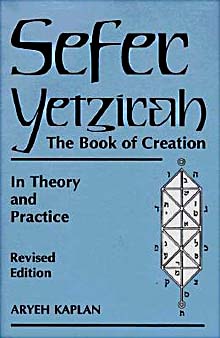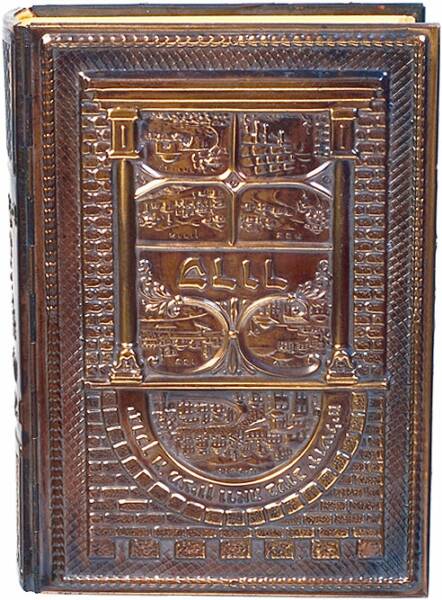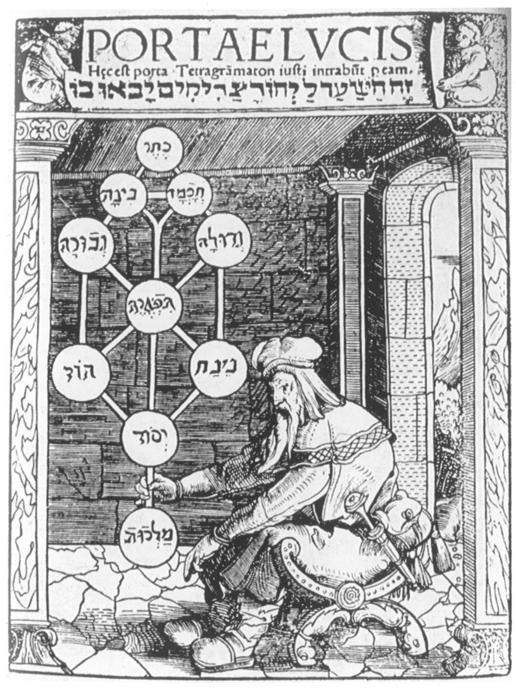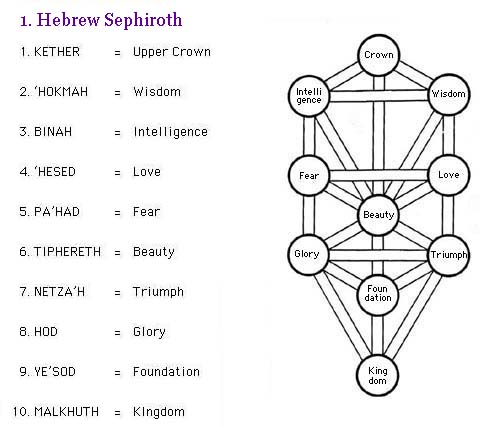The Holy Kabbalah is the mystical side of Judaism (from "kibbel" - to receive). It
comprises a series of techniques or practices to help centre life around the
Divine. It is a systematic body of wisdom about the Divine, which is technically
a Theosophy rather than a religion. It can be practised by non-Jews as well as
by Jews. This is just as well, since it is remarkably difficult (and not necessary)
to convert to Judaism. In the Renaissance some Christian and Humanist scholars started to learn about Kabbalah and applied it to non-Jewish topics. This Gentile strand is often referred to as Qabalah or Cabbalah, to distinguish it from the religious orthodoxy of the root, Kabbalah. Much of the Kabbalah involves studying a diagram called the Tree of Life.
Ethics
Non-Jews will be called Righteous Gentiles and can expect to enjoy the afterlife - if they follow the Seven Laws of Noah, which were recognised by the United States Congress. These laws comprise bans on idolatry, blasphemy, murder, theft, sexual immorality, eating the limb of a living animal, and a positive injunction to set up Courts of Law. Obviously this is a shorter list than the Mosaic Ten Commandments and is not entirely negative.
The Noahide Laws ought to be kept in mind by Gentiles learning the Kabbalah. They have been interpreted in a way that actually bans many more activities than appear at first sight. As you can imagine, there have been lively debates about their exact meaning. It is beneficial to study them in detail and form your own views, based on your own understanding of life and that of wise commentators. I need to introduce these ethical considerations early on, as you will see if you read widely that not everyone has a deep ethical basis for their pursuit of this knowledge. But we can learn even from those who make mistakes, if only "what not to do" and what the consequences may be. In particular, note that the true Kabbalah is not about making large sums of money or the setting up of misguided cults. The true Kabbalist will charge no more than reasonable expenses for providing tuition and will seek to follow divine guidance rather than the human ego.
The rainbow given as a sign by God to Noah is the modern symbol of the Noahide movement. (The story of the flood and the rainbow was adapted by a Biblical writer from an earlier story in Mesopotamia, in which the rainbow is the girdle of the goddess Ishtar or Inanna. The writer adapted it to fit his own monotheistic beliefs.)
The Age of the Kabbalah
Some texts are as much as two thousand years old, e.g. the Sefer Yetzirah. This is a short, concise text, that looks like summary notes taken from a teaching session. There would have been oral teaching to expand its meaning. Nevertheless it will yield much to careful study even now. The commentary by Aryeh Kaplan (Weiser, revised edition 1997) is outstanding.



 Before this period came the Merkabah Mystics or Riders of the Chariot. They made
Before this period came the Merkabah Mystics or Riders of the Chariot. They made



 mystical internal journeys and recorded their teachings in the Hekhaloth texts. They
mystical internal journeys and recorded their teachings in the Hekhaloth texts. They




 believed that the devout and properly prepared individual could journey to God by
believed that the devout and properly prepared individual could journey to God by
ascending through Seven Heavens. This is based on the Vision of Ezekiel. It is
possible that this practice originates ultimately in the Sacred Tree practises of Asiatic
Shamans, followed since time immemorial, or else it arose separately out of a shared
but little understood psychological basis.
According to Professor Simo Parpola of the University of Helsinki, the Assyrian
Tree of Life (right), which was depicted on palace walls in Northern Iraq, is the direct
ancestor of the Jewish Tree of Life. He regards this diagram as a Family Tree of the
major Assyrian Gods, and the Hebrew names given to Sefiroth on the Tree are direct
translations of the relevant Assyrian words. (It should be noted that the Assyrians
and Babylonians took many Jews into captivity in Iraq when their Empires ruled
the Middle East. Consequently there was a sizeable Jewish community in
Mesopotamia for many centuries thereafter, which produced the Babylonian
Talmud.) Although many Assyriologists are not persuaded of the truth of the theory,
it has found a following among Kabbalists.
The Tree of Life symbol and its ten circular Sefiroth (or numbered locations for divine qualities, from the Hebrew word for counting) are already apparent in the Sefer Yetzirah. The absence of earlier texts about the Tree is not in itself a proof of a gap in the argument, just a common situation for traditions of that age and earlier. Many "ancient texts" are late copies no more than 1,000 years old.





